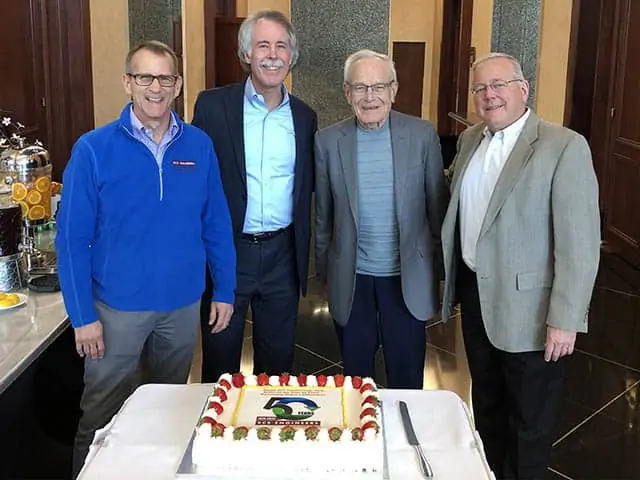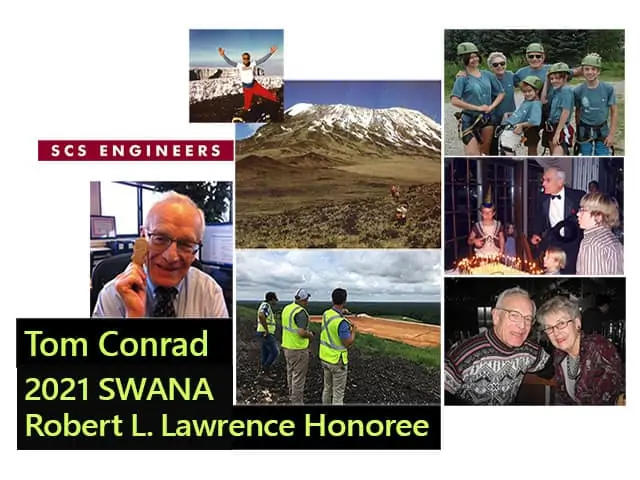

Meet SCS Engineers and SCS Field Services professionals at BOOTH 1704 at WasteExpo 2023, May 1-4, in New Orleans.
WasteExpo is the place to be! The conference program is your professional development opportunity of the year! The education and training that you’ll receive is guaranteed to sharpen your skills to help you do your job better. WasteExpo’s conference program is unparalleled. 2023 Conference Tracks include:

Monday, May 1
8:00 AM – 9:15 AM
Room: 275, Session Number: MTECH1

Monday, May 01, 2023
8:30 AM – 9:45 AM
Room: 279, Session Number: MRECYC1

Monday, May 01, 2023
10:15 AM – 11:30 AM
Room: 279, Session Number: MRECYC2

Tuesday, May 02, 2023
8:00 AM – 9:15 AM, Room: 289, Sustainability Track
Seizing an Opportunity: The Rise of MRF Investments with Bob Gardner, Sr. VP Solid Waste
Tuesday, May 02, 2023
12:00 PM – 1:15 PM
Room: 279, Session Number: TRECYC3

Wednesday, May 03, 2023
10:45 AM – 12:00 PM
Room: 275, Session Number: WTECH2
Click for more conference details and registration information
In a letter to Congress, SWANA and NWRA associations request that regulation under the Comprehensive Environmental Response, Compensation, and Liability Act (CERCLA) for addressing per- and polyfluoroalkyl substances (PFAS) contamination assign environmental cleanup liability to the industries that created the pollution in the first place. Both associations note that MSW landfills and solid waste management, an essential public service do not manufacture nor use PFAS. The industry, and ultimately the general public should therefore not be burdened with CERCLA liability and costs associated with mitigating PFAS from water and wastewater.
May 10, 2022
Re: Relief for Municipal Solid Waste Landfills from CERCLA Liability for PFAS
Dear Chairman Carper, Ranking Member Capito, Chairman DeFazio, Ranking Member Graves, Chairman Pallone, and Ranking Member McMorris Rodgers:
The municipal solid waste (MSW) management sector strongly supports the goal of addressing per- and polyfluoroalkyl substances (PFAS) contamination and holding accountable manufacturers and heavy users of these compounds. We are concerned, however, that regulation under the Comprehensive Environmental Response, Compensation, and Liability Act (CERCLA) instead would assign environmental cleanup liability to essential public services and their customers. We therefore request that Congress provide MSW landfills and other passive receivers with a narrow exemption from liability if certain PFAS are designated as hazardous substances under CERCLA. Doing so would keep CERCLA liability on the industries that created the pollution in the first place.
Context
• Landfills neither manufacture nor use PFAS; instead, they receive discarded materials containing PFAS that are ubiquitous in residential and commercial waste streams. MSW landfills and the communities they serve should not be held financially liable under CERCLA for PFAS contamination, as landfills are part of the long-term solution to managing these compounds.
• Landfills are essential public services that are subject to extensive federal, state, and local environmental, health, and safety requirements. Further, MSW landfills are important to managing and limiting PFAS in the environment, as recognized by the Environmental Protection Agency (EPA) in its December 2020 draft Interim Guidance on the Destruction and Disposal of [PFAS] and Materials Containing [PFAS].
• Just as certain airports are required by law to use firefighting foam containing PFAS, permitting authorities often require landfills to accept waste streams containing PFAS.
• Most landfills rely on wastewater treatment facilities for leachate management. Wastewater and drinking water facilities increasingly rely on landfills for biosolids management and disposal of PFAS-laden filters. Efforts to address PFAS at MSW landfills and drinking water and wastewater facilities must avoid disrupting this interdependence among essential public services to communities.
• Landfill leachate typically represents a minor proportion of the total quantity of PFAS received at wastewater treatment facilities from all sources. PFAS manufacturers or users, by comparison, contribute PFAS at levels that can be orders of magnitude higher than landfills.
Significant Economic Impacts
• Removing PFAS from landfill leachate requires advanced treatment techniques which are prohibitively expensive. Estimated capital costs to implement leachate pretreatment at a moderate-sized landfill to the extent necessary to significantly reduce PFAS range from $2 million to $7 million, with nationwide costs totaling $966 million to $6.279 billion per year for the solid waste sector. Trace concentrations of PFAS nevertheless would remain in leachate following pretreatment, exposing landfills to CERCLA liability.
• Absent relief from CERCLA liability, manufacturers and heavy users of PFAS compounds will bring claims for contribution against landfills and other passive receivers, generating significant litigation costs. EPA’s exercise of enforcement discretion will not insulate landfills from this litigation.
• These costs will be passed along to communities, water and wastewater treatment facilities, and biosolids management, all of which rely on the services of MSW landfills.
Broad Unintended Consequences
• CERCLA regulation will impel landfills to restrict inbound wastes and/or increase disposal costs for media with elevated levels of PFAS, including filters, biosolids, and impacted soils at Department of Defense facilities. The mere prospect of regulation in this area is already disrupting the interdependence of the drinking water, wastewater, and solid waste sectors.
• Food waste compost may contain PFAS due to contact with PFAS-lined packaging materials. As a result, a CERCLA designation could result in communities diverting food waste from organics recycling programs, hindering federal, state, and local climate and waste reduction goals.
• Cost increases likely will have a significant disproportionate impact on low-income households that rely on the affordability of services that the solid waste sector provides.
Recommendation
Although our sector is simultaneously pursuing “no action assurance” from EPA, the agency historically has been very hesitant to provide this relief given its policy that assurances should be given only “in extremely unusual cases.” As such, and acknowledging that EPA may have limited authority to act on our request, we recommend providing the following narrow exemption from CERCLA liability that affords relief to landfills and other passive receivers of PFAS1:
(a) IN GENERAL.—No publicly owned or operated community water system (as defined at 42 U.S.C. 300f), publicly owned treatment works (as defined at 33 U.S.C. 1292), or municipal solid waste landfill (as defined at 40 C.F.R. 258.2) shall be liable under the Comprehensive Environmental Response, Compensation, and Liability Act of 1980 (42 U.S.C. 9601 et seq.) for the costs of responding to, or damages resulting from, a release to the environment of a perfluoroalkyl or polyfluoroalkyl substance designated as a hazardous substance under section 102(a) of such Act that resulted from the discharge of effluent, the disposal or management of biosolids, the disposal of filtration media resin, or the discharge of leachate where such actions are in compliance with Federal or State law and all applicable permits.
(b) EXCEPTION.—Subsection (a) shall not apply with respect to any discharge described in such subsection that results from any gross negligence, willful misconduct, or noncompliance with any Federal or State law or permit governing the discharge of effluent, disposal or management of biosolids, disposal of filtration media resin, or waste disposal.
Thank you for your consideration of our request, and we look forward to continuing to partner with the federal government to ensure the safe and effective management of waste streams containing PFAS.
Sincerely,
National Waste & Recycling Association
Solid Waste Association of North America
cc: Senate EPW Committee Members
House T&I and E&C Committee Members
_______________________________________
1 The exemption would not extend to underlying soil and groundwater contamination from a MSW landfill or to facilities other than MSW landfills that accept waste streams with elevated concentrations of PFAS.
Recycling and reuse started in 1987 and continues today with cities embracing public-private partnerships with their recycling processors. They recognize the vital and interrelated role of both the public and private sectors in recovering recyclables. In the U.S., manufacturing and end-use markets are seeing more demand for recyclable materials. Companies are held accountable for misleading advertising instead of changing packaging or labeling how to recycle clearly.
Through leadership, innovation, and strategic planning, cities continue to help lead the way on recycling to achieve landfill diversion and provide for more environmentally and financially sustainable solid waste management systems for the next 30 years.
Read more from the authors of this up-lifting article, The Journey of Recycling, in the March edition of APWA.
The City of Lincoln’s Transportation and Utilities (LTU) Department/Solid Waste Management Division manages all solid waste generated within its service area to protect the public’s health, safety, welfare, and environment. They do so cost-effectively and in compliance with its solid waste management plan, Solid Waste Plan 2040. The plan, updated in 2020 through a process facilitated by SCS Engineers, produces remarkably good results.
The City undertook a comprehensive residential and commercial recycling communication, education, engagement, and behavior change initiative.
Read more about Lincoln’s success and see results in this APWA article (March 2022 edition).
New Chicago office location at 40 Shuman Boulevard, Suite 216, Naperville, IL 60563
SCS Engineers continues expanding its environmental team in its Chicago, Illinois office to meet environmental engineering and consulting needs focusing on waste management and the needs of the electric utilities. Driving demands are industries and municipalities seeking to reduce their environmental footprint while providing essential services and products.

Meet the Crew!

Brett Miller is a Senior Designer with over 20 years of experience and proficiency in AutoCAD Civil 3D and Maya. Brett is capable of any production drafting and is highly skilled in understanding 3D space. This helps him support designs that fit into site-specific, real-world environments. Brett also creates 3D models and animations that illustrate the benefits of a design to our clients.
Niko Villanueva, PE, joins SCS with eight years of experience. Niko provides engineering and drafting support and is experienced in designing various landfill systems such as stormwater management, leachate and gas control, and foundation analysis. He has also prepared cost estimates and construction bid quantities for various projects and construction quality assurance services at multiple facilities.


Route Optimization for Waste Collection Finds Surprising Benefits for Even Small Municipalities
Running optimized collection routes is critical for a waste company’s or municipality’s bottom line; it’s also a dauntingly complex job. This is where experts skilled in waste collections route optimization come in. There could be thousands or more ways to get from one service point to the next along a single route; now think about an intricate web of routes traversed by a whole fleet. Then throw in other possible variables, like different route densities, overlapping vs. non-overlapping routes, and holiday and inclement weather schedules. And if you are like one fast-growing Midwestern city, you have plenty more to take on as you work to stay on top of that growth and changes that come with it.
Geographical Information Systems (GIS) help achieve collection route optimization.
One way this Midwest municipality stood up to the challenges is with GIS, which stores, processes, analyzes, and maps spatial data. SCS Engineers’ Emily Smith helped the city leverage the technology to identify and make needed changes, better serve customers, and ultimately save money and time.
“When we came in to help, they had multiple small routes scattered across their service area, which was a problem that became more difficult as the city was growing. Haulers were putting in a lot of overtime to meet deliverables while complying with regulations restricting driving hours. They needed to take more breaks between driving time to stay within those limits, which stretched out their days further,” Smith says.
“Then there’s the wear and tear on tires and the trucks themselves and fuel cost, among issues.”
Working with route optimization consultant Kevin Callen, she used GIS to help restructure and better balance routes.
An ecologist, Smith started using the technology years ago to map out wetlands and for groundwater monitoring. That gave her the knowledge base to figure out how to develop maps to optimize collection routes; these powerful systems are flexible, with broad capabilities and applications.
“I like identifying where there is room for improvement and making visual representations of projects so clients can see the scenario as more than numbers on a page. It tells a story and makes it easier to grasp when they have a visual, color-coded representation,” Smith says.
GIS is useful to map out garbage carts and recycling carts down to an individual customer or street and the number of houses in a neighborhood. It can identify one-way streets or low bridges that larger trucks may need to bypass, among relevant information to plan the most efficient paths. We layer these details and other customizable data to get a comprehensive picture to help design the plan.
Smith began by teasing out information that the city already had. Using surveys created with targeted questions, she could obtain information about specific route challenges (tight alleyways, street parking, confusing setout locations, etc.). The information helped inform potential route modifications.
The outcomes for the Midwest municipality:
Existing waste routes can be modeled in GIS and revised that show impact before and after revisions under consideration. This capability extends beyond fine-tuning residential collection routes. For instance, GIS can do geoprocessing of data to calculate where to put a recycle drop-off center or transfer station that will service a given number of customers.
Additional supports weaved into GIS.
Besides saving labor, travel time, and fuel and vehicle maintenance expenses, routing has more qualitative aspects of gaining efficiencies.
“By talking to collectors with boots on the ground, we find ways to enhance driver safety by identifying problem areas like locations prone to flooding and those with low-hanging tree branches or power lines. Leveraging GIS can also help reduce truck impacts to roads and neighborhoods and reduce emissions. And it can help address customer service issues — for instance, by mapping and taking notes on special backdoor service customers with limited mobility, collectors know to pick up their bins closer to their homes,” says Ryan Duckett, an SCS engineer who leverages GIS to support clients on the East Coast.
For one Texas city, it was a way to systematically and quickly clean up volumes of existing data that had inaccuracies. This was key to later being able to perform an analysis providing intel for route load balancing.
“There were approximately 200 points that needed to be updated to reflect their actual locations. We provided a method to verify and change the information via an online interactive GIS mapping application. They can edit each field, inputting appropriate route information,” says SCS’s Brooke Aumann, who has 14 years working with GIS. The municipality used this same system to review the new routes and provide comments, allowing its staff to be an active collaborative partner in optimizing each route, Aumann says.
Curbside waste collection is hard work. It involves a lot of physical labor, operating heavy equipment, adhering to tight schedules, and sometimes pivoting fast.
“Having this powerful tool that enables us to streamline the process and make collections easier and more efficient is a big plus, especially as we continue to expand and improve other waste and recycling services that depend on, or impact, collections. GIS is a unique opportunity to apply computer technology to come up with practical approaches to real-life problems and realize substantial savings in time and money,” Duckett says.
The International Awards Committee and Solid Waste Association of North America (SWANA) Board of Directors unanimously voted to honor Tom Conrad, the “C” in SCS, with the Robert L. Lawrence Distinguished Service Award at WASTECON 2021 in November. The Lawrence award is the highest accolade SWANA bestows on a member of the waste management industry, reserved for those making meaningful and lasting contributions.
“I’m honored and humbled to be selected for the Robert L. Lawrence Award. I thank you and am especially thankful for what SWANA and SCS are today,” stated Tom Conrad.
SWANA recognizes Conrad for over 60 years of significant influence on the waste management and environmental services industry. Conrad, a Founder, Executive Vice President, and Director Emeritus of SCS Engineers, dedicated his career to advancing solid waste management, most notably through the founding of SCS Engineers (Stearns, Conrad, and Schmidt Consulting Engineers) more than 51 years ago.
Tom Conrad worked on a wide range of environmental engineering projects touching almost every aspect of solid waste management throughout his career. As an environmental engineering firm and consultant to the newly created US Environment Protection Agency (EPA), the founders recognized that responsible solid waste management was increasingly important for protecting the environment and the health and safety of the general public.
Leading SCS, he helped the EPA develop the first federal regulations for sanitary landfills, managing and capturing landfill gas, waste sorting protocols, sludge management, and land remediation.
Environmental services, including wastewater management, were always a significant part of SCS services and the waste industry. When new regulatory policies began expanding in the ’80s, SCS’s techniques, technology, and expertise helped a broad range of industries comply with environmental needs and continues today with the firm’s greenhouse gas, landfill technology, renewable energy, remediation, and sustainable materials management programs.
Conrad is also known for hiring and mentoring today’s SCS leaders, many of whom are SWANA leaders, by creating and fostering SCS’s culture encouraging employee participation in industry associations, community, and SCS’s mentorship and leadership programs.

Before his retirement in 2016, Conrad held professional engineering licenses in 24 states. He was a member of SWANA, the American Society of Civil Engineers, the National Waste and Recycling Association, and the Society of American Military Engineers.
He maintains his “work hard – play hard” lifestyle. He is active at SCS, participating in Board of Director meetings and speaking at the Young Professionals Group events and celebrations. While no longer mountain climbing and biking cross-country, he has a vigorous walking, swimming, and biking schedule.

With the frequency and severity of storms on the rise, municipal solid waste landfill operators have to think differently to keep their workers and environment safe. Planning is key to safely hit the ground running in the wake of severe weather.
Federal law does not hold household hazardous waste (HHW) to the same standards as what is classified as hazardous waste (generated by businesses and received at subtitle C landfills). Yet, these materials have the same compounds and are potentially dangerous too.
“Subtitle D landfills routinely receive these wastes, but under normal conditions, it’s in much smaller quantities, and they are typically segregated. So managing them is not a big deal. But, after a storm, operators can be inundated with these oxidizers, corrosives, flammable gases, and flammable solids. It’s all coming in at once and mixed with other storm debris, posing a risk for reactions and workers’ safety,” says Mike Knox, SCS Quality Advisor. He supports landfill operators in safely managing hazardous wastes. Storm season is a busy time for him and his clients. Those unprepared find themselves pulled in multiple directions and need to act quickly and smartly.
If a structure blows down, it may generate waste that contains gallons of dangerous liquid, gas containers, propane tanks, and pesticides mixed in. It’s dangerous, especially if a waste worker does not see it.
Mike’s Planning Advice
Operators set themselves up for success when they’re ready to go with a plan before that first 80-mile-an-hour wind gust hits.
“You must know how to identify hazardous wastes ahead, train staff ahead, and look at worse-case scenarios ahead,” Knox says.
He and his team start by looking at operators’ facilities and identifying materials, workers’ roles, and available equipment and assets. They identify safety areas and set up classrooms. Important are preparing the staging areas to manage the influx, screen, and segregate by waste type.
Then they look at government rules; help operators determine what they need to do; and execute a plan.
Minimizing Risk
Operators need to secure waste, make sure it’s packaged right, and minimize it where possible to stave off mishaps.
The safety of people and equipment is part of a proactive strategy. Trucks can tip over with heavy, wet loads, so do not overload them. Space trucks in the tipping area are at least 10 feet further apart than the dump trailer is long. For a 30-foot trailer, that’s 40 feet.
Setting up this extra space can be difficult unless you’ve established a large tipping area, and don’t take chances with dump trailers; the results have proven deadly in the past, Knox advises.
Check that backup alarms and strobe lights are working. Train equipment operators to look for vehicles and pedestrians. Do not allow cell phones at the working face; a distraction that no one needs. Mandate the use of high-visibility vests and restrict people to stay within five feet of their vehicle. Strictly control scavenging. People cannot wander and pull items from the trash.
Fuel Up
Fuel is the item most often overlooked in Knox’s experience.
“Having enough fuel to operate heavy landfill equipment and hauling fleets is essential to keep waste moving. Severe storms have impacted fuel supplies for several days to a week or more, so stock up,” he recommends. Mike typically arranges for temporary fuel storage tanks so haulers and heavy equipment operators can stay on their mark through and after the storm.
Scenarios in Preparation
Part of safety management is asking “what if” and then answering ahead of a problem. Depending on where ‘what if’ leads, you prioritize and go after the big things first. One big one is, what if floods occur? That question leads to more specifics to plan for, such as roads likely to be impacted and establishing alternate routes available. What other actions will help traffic flow?
Remember: if there’s a lot of rain or clay, trucks can slip going up hills. So alternate tipping areas that are lower and flatter may be needed to accommodate inclement weather access. “And that takes preparation. Sometimes you have to build a road to reroute to an area you are not using. It can take days,” Knox says.
Building wet weather access roads are important, as are measures like cleaning out stormwater ditches. Nevertheless, know that, depending on location, rising water may flood out areas despite these efforts. Pumping water into berms and ponds from flooded ditches can be a temporary solution if your plan and local regulations allow it. Coordinate with regulatory and permit agencies to set up such actions.
You will want to bolster protections of maintenance facilities, the scale house, and other structures that could be damaged or lose power – stock up on tarps, lumber, and power generators.
Many operators find waste screening towers to be especially useful. Knox and his team will build them in advance to prepare for what’s coming. Waste screeners at the gate radio to active face supervisors if hazardous materials are arriving so they can properly place them, ensuring they are covered with dirt before sending staff to the active face.
Knox completes quality evaluations guided by a 200-item checklist to ensure proper procedures are in place. He compliments this list with many questions to prepare.
Know Your Jurisdiction’s Rules and Storm Accommodations
Operators check local permit conditions to take advantage of possible modifications they may make. Some jurisdictions have more lenient weight restrictions for hauling vehicles or the option to set up temporary staging areas.
Knox also suggests coordinating with the local permit and regulatory agencies following the storm to take advantage of emergency relief funds and coordinate across the area’s public and emergency services.
Local government, emergency responders, regulatory and permitting agencies often have Emergency Operations Centers (EOC) to coordinate resources, information, and crisis management. Mayors, County Commissioners, fire departments, hospitals, police, environmental regulatory agencies, and other key industry leaders are typically part of this team.
These groups practice response coordination and stage tabletop exercises or mock disasters. “Take time to participate and plan with the EOC. Check for whatever else may be available in your area to help prepare, and work as a team with these local entities to respond to severe weather or other emergency events,” Knox says.
Circling Back to Planning
“Knowing what to do before the storm hits will make your recovery easier. You will keep your employees, your community, and your site safe. And be ready to go back to normal operations much faster.”

Media Borough, Pennsylvania’s Food Compost Program uses a witty video encouraging participation in its organic waste diversion and composting program. We had to share – not only is it fun – it works!
The Borough launched its pilot program to gauge the feasibility of adding food scrap collection to its current recycling efforts. This month the program is available to all residents. The food scrap collection program provides residents the opportunity to separate food from the rest of their household waste for collection and composting at a local compost farm.
Media Borough estimates it has 70% recycling participation in the community – that’s an impressive number. Its current recycling and yard waste programs divert close to 30% of residential solid waste from landfills and incinerators. Adding a food scrap collection program can reduce residential waste by another 30% and create compost.
The Borough’s Public Works website explains the reasons why organic matter, matters.
Thank you to this Pennsylvania community and its Public Works department for helping to sustain future generations with their reduce, reuse, and recycling actions. We hope by sharing their video and results, we’ll see greater participation in communities nationwide.
Achieving Florida’s 75% Recycling Goal presents unique challenges and opportunities for policymakers and professional staff. Across the country, local governments who had become accustomed to receiving operational cost offsets from their recyclable materials are now paying higher fees to continue their recycling programs. Renewable News covers how Leon County and the city of Tallahassee are managing both through their partnership.
They are uncovering opportunities to improve upon current operations, including but not limited to potential changes to facilities, infrastructure, programs, and partnerships. New opportunities are helping both develop long-term policy strategies and recommendations to continue a financially viable recycling program and meet goals.
Read and share the article here.